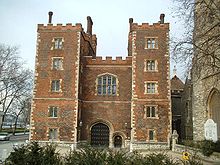| Revision as of 21:59, 7 March 2004 editKent Wang (talk | contribs)Extended confirmed users2,060 editsm copy edit← Previous edit | Revision as of 22:03, 7 March 2004 edit undoMorwen (talk | contribs)Administrators56,993 editsm fix apostropheNext edit → | ||
| Line 2: | Line 2: | ||
| '''Lambeth Palace''' is the palace of the ], located in ] on the ] opposite the ]. It was acquired by the archbishopric around ]. | '''Lambeth Palace''' is the palace of the ], located in ] on the ] opposite the ]. It was acquired by the archbishopric around ]. | ||
| The oldest part of the palace remaining is the ] ]. The so-called ] Tower, which retains evidence of its use as a ], dates from ]. There is a fine ] brick gatehouse built by ] in ], and the hall, built by ] is dated ], and has a ] roof. The portion now inhabited by the archbishops was built in ] and fronts a spacious quadrangle. Among the portraits of the archbishops here are examples by ], ], ] and Sir ]. There is a valuable library. The church of St Mary was rebuilt around ], though the ancient monuments preserved give it an appearance of antiquity. Amongst them are tombs of some of the archbishops, including ], and of the gardeners and plantsmen ] and his son. | The oldest part of the palace remaining is the ] ]. The so-called ]'s Tower, which retains evidence of its use as a ], dates from ]. There is a fine ] brick gatehouse built by ] in ], and the hall, built by ] is dated ], and has a ] roof. The portion now inhabited by the archbishops was built in ] and fronts a spacious quadrangle. Among the portraits of the archbishops here are examples by ], ], ] and Sir ]. There is a valuable library. The church of St Mary was rebuilt around ], though the ancient monuments preserved give it an appearance of antiquity. Amongst them are tombs of some of the archbishops, including ], and of the gardeners and plantsmen ] and his son. | ||
| ==See Also== | ==See Also== | ||
Revision as of 22:03, 7 March 2004

Lambeth Palace is the palace of the Archbishop of Canterbury, located in London on the Thames opposite the Palace of Westminster. It was acquired by the archbishopric around 1200.
The oldest part of the palace remaining is the Early English chapel. The so-called Lollard's Tower, which retains evidence of its use as a prison, dates from 1440. There is a fine Tudor brick gatehouse built by John Morton in 1495, and the hall, built by William Juxon is dated 1663, and has a hammer-beam roof. The portion now inhabited by the archbishops was built in 1834 and fronts a spacious quadrangle. Among the portraits of the archbishops here are examples by Hans Holbein, Anthony van Dyck, William Hogarth and Sir Joshua Reynolds. There is a valuable library. The church of St Mary was rebuilt around 1850, though the ancient monuments preserved give it an appearance of antiquity. Amongst them are tombs of some of the archbishops, including Richard Bancroft, and of the gardeners and plantsmen John Tradescant and his son.